Five ways to save money in one of the world’s most beautiful places
There’s no doubt that Seychelles is an exotic locale: dreamy turquoise waters wrapped with ribbons of white sand, coconut palms, giant boulders, jungle-cloaked hills and colourful culture dotting the Indian Ocean.
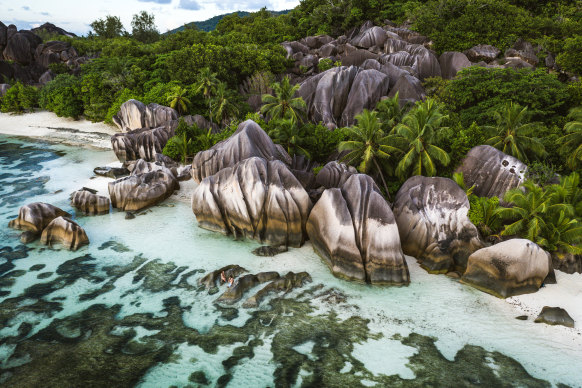
Anse Source d’Argent in the Seychelles is considered one of the world’s most beautiful beaches.Credit: iStock
Getting there from Australia is quite an effort: it requires multiple flights to the 115-island archipelago north of Madagascar, which is perhaps too far for some.
And then there’s the cost factor: the tiny East African nation is known for not being wallet-friendly – even after you get there, daily expenses can be steep.
But it doesn’t have to be that way. There are ways to sunbathe, sip on Takamaka rum and save in the Seychelles in five easy steps.
Eat takeaway – and lots of it
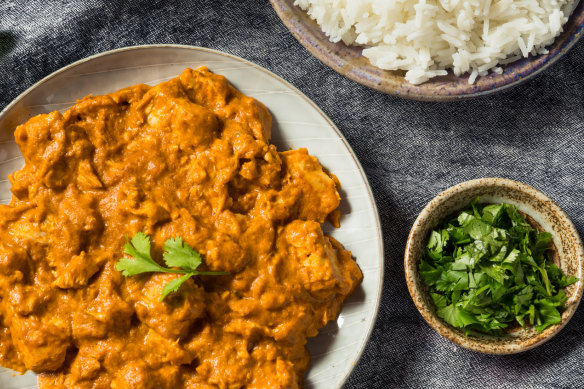
Seychellois Creole cuisines blend Indian, Asian and European influences.Credit: Getty Images
Takeaway is not a dirty word in Seychelles. It’s also vastly different to what we deem to be fast food back here in Australia.
Grabbing a quick feed for lunch and dinner is a way of life for locals. Takeaway is typically home-cooked Seychellois Creole cuisines – a hybrid of Indian, Asian and European influences. Expect to see traditional curries, rice, noodles and grilled or fried fish and seafood on the menu. Other options include vegetables, chicken, pork, beef, and if you’re game enough, bat.
At many takeaway outlets, food is presented in a bain-marie. It’s the cheapest meal option, with mixing and matching dishes from as little as 50 rupees ($5). Some outlets offer meals made fresh to order, and both options are presented in no-frills packaging. Western favourites like burgers, fried chicken, spaghetti and pizzas may also appear on menus.
How to decide where to get your takeaway from? Look for the queues. A delicious example: A freshly grilled tuna fillet served in a burger, with chips, from Mahe’s Leo’s Food Bus at popular tourist beach Beau Vallon set me back 125 rupees ($14).
It’s also common to find small, deep-fried snacks such as samosas in convenience stores for around 10 rupees ($1), perfect for a quick tide-me-over before the next meal.
Island-hop the Vanilla Islands
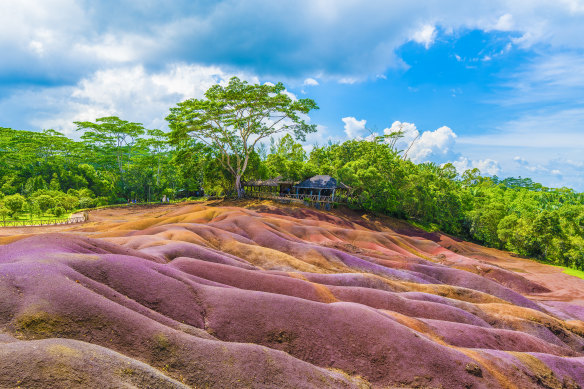
Seven Coloured Earths, a spectacular geological formation on Mauritius.Credit: iStock
Make the most of an expensive flight route to Seychelles by discovering the rest of what’s been dubbed the “Vanilla Islands”: the other island nations Comoros, Madagascar and Mauritius, and the French territories of Mayotte and Reunion. Mauritius is the easiest to access from Australia and is a convenient stopover when visiting the Seychelles.
Air Mauritius flies direct from Perth three times weekly and takes just over eight hours to arrive in Mauritius. (You can fly from Adelaide, Brisbane, Melbourne and Sydney via Perth with Virgin Australia.)
Mauritius, the former home of the dodo, is famed for its weirdly pointed peaks, rainbow-coloured volcanic terrain, sugar cane plantations, waterfalls, sublime diving and, yes, beautiful beaches all around.
Then fly Air Seychelles to Seychelles’ capital, Victoria, on Mahe Island. The direct flight operates three times weekly and takes 2½ hours, which is less time than it takes to watch any Lord of the Rings movie. The remaining Vanilla Islands are likewise only a short flight away.
Stay local with a local
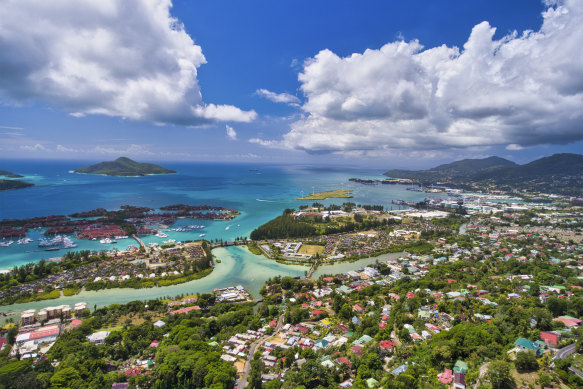
Family-run guesthouses are a more economical alternative to resorts.Credit: Getty Images
Enjoy paradise without the high costs by choosing a simple night’s sleep. Family-run guesthouses are common in Seychelles and are a budget-friendly option compared with luxe beachside resorts and villas. They also enable you to mingle with locals and gain insight into everyday life and practices.
Expect room furnishings to be simple, homely and equipped with the basics. Some fixtures or interiors may even provide an enduring time warp, such as dated photography or dainty curtains, but it all adds to the charm and authenticity.
You may miss out on luxury comforts and an unfiltered view of a crystal-clear beach from your doorstep, but the willingness to walk an extra few metres can save you hundreds.
I stayed at a guesthouse less than 400 metres from Beau Vallon – Mahe’s most famous beach – for just over $100 a night per room. The short walk to the coast allowed me to appreciate a sense of place and be immersed in the local beachside community.
Most importantly, guesthouses serve the same function as a hotel – a place to drop your bags, shower, sleep and repeat.
Consider your transport options
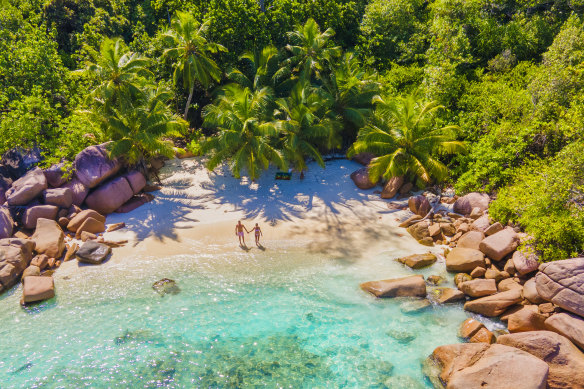
The cost of beach excursions can add up quickly when using taxis and tours.Credit: Getty Images
If you’re a solo traveller, this is where costs hit hardest – getting around. Taxi hire is expensive, so if you’re travelling with multiple people, consider renting a car. It’s a cost-effective way to get around Mahe or Praslin and could also save you on escorted tours. Visit waterfalls, local markets, heritage buildings, hiking trails and, of course, beach-hop on your own terms.
Not wanting to hire a car or taxi? Get around like a local by hopping on a big, blue bus. Buses are the cheapest way to get around Mahe and Praslin, and are operated by the Seychelles Public Transport Corporation (SPTC). Buses have recently become cashless: an STPC bus card is required with fares from 7 rupees (78¢). By far the cheapest option, the compromise of getting around by bus is experiencing a little discomfort. Expect to get up close and personal with locals as buses are usually packed, so if you score a seat, consider it hitting the jackpot. Do note that because of high loads, suitcases or big bags are not permitted on buses.
If travelling to La Digue, forget the need for a taxi or car hire together. Bikes rule on the 10 square-kilometre territory and are 150 rupees ($16) a day to hire, although there is room to negotiate for multiple-day hire.
As for island-hopping, Cat Cocos is the main fast ferry service provider offering economy and business class seating. Travel Mahe to Praslin one way (1¼ hours direct) from 840 rupees ($87) or Praslin to La Digue (15 minutes) from 170 rupees ($18).
Explore Seychelles’ natural assets
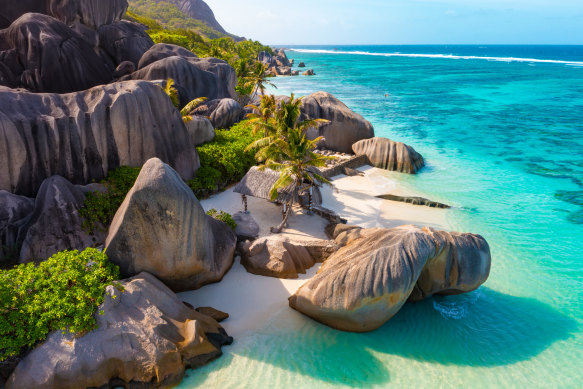
La Digue’s Anse Source d’Argent is one of the world’s most photographed beaches.Credit: Getty Images
Seychelles’ biggest attraction is nature. Most famously, its beaches. Mother Nature really did spoil Seychelles with a paradisal coastline. The country boasts the “world’s most photographed beach”, La Digue’s Anse Source d’Argent, and there’s not much guessing why – it is a Shangri-La. While you have to pay 150 rupees ($17) to gain access to L’Union Estate Park, where you’ll find the famous beach, there are many other beautiful beaches that are free.
Under the sea is just as spectacular. The country’s glistening warm waters are teeming with marine life corals, with entry into this colourful universe a few flipper strides from shore. Avid snorkelers and divers will be impressed: The 41 Inner Islands are some of the oldest mid-oceanic granite islands on Earth, while the Outer Islands comprises 74 coral atolls, which offers divers a chance to explore pristine reefs and ancient landscapes.
Back on land there are more unique sights. For the ever-patient and adventurous, there’s Aldabra Atoll. The UNESCO World Heritage Site is the largest raised coral atoll and has the largest population of Aldabra tortoises in the world. While trips to the far-flung island via dive boats, expedition cruise ships and yachts are sporadic, it’s possible to see these giant tortoises at L’Union Estate Park. Now that’s two incredible sights – Anse Source d’Argent and giant tortoises – for the price of one! Double-dipping at its finest.
Another UNESCO World Heritage Site is Vallee de Mai Nature Reserve on Prasil. Here, you’ll find the rare palm species, coco de mer. It produces the world’s largest nut, famed for looking like a double coconut or, cheekily, a bottom. Seychelles’ botanical icon is only found on two islands, with a visit to the nature park 450 rupees ($50). It couldn’t get more exotic than that.
THE DETAILS
Fly
There are no non-stop services to Seychelles from Australia. Air Mauritius flies three times weekly, direct from Perth to Mauritius, with connections from Australian cities via partner airline Virgin Australia. Air Seychelles flies three times weekly from Mauritius to Mahe in Seychelles. See airseychelles.com; airmauritius.com
Stay
Rooms at Zerof Guesthouse start from 1261 Seychellois rupees ($138) a night, minimum two-night stay. See zerofguesthouse-seychelles.com
Explore
Cat Cocos journeys from Mahe to La Digue multiple times daily from 2020 rupees ($220) return. See catcocos.com
The writer travelled to Mauritius as a guest of Air Mauritius, and on to the Seychelles at her own expense.
Sign up for the Traveller Deals newsletter
Get exclusive travel deals delivered straight to your inbox. Sign up now.